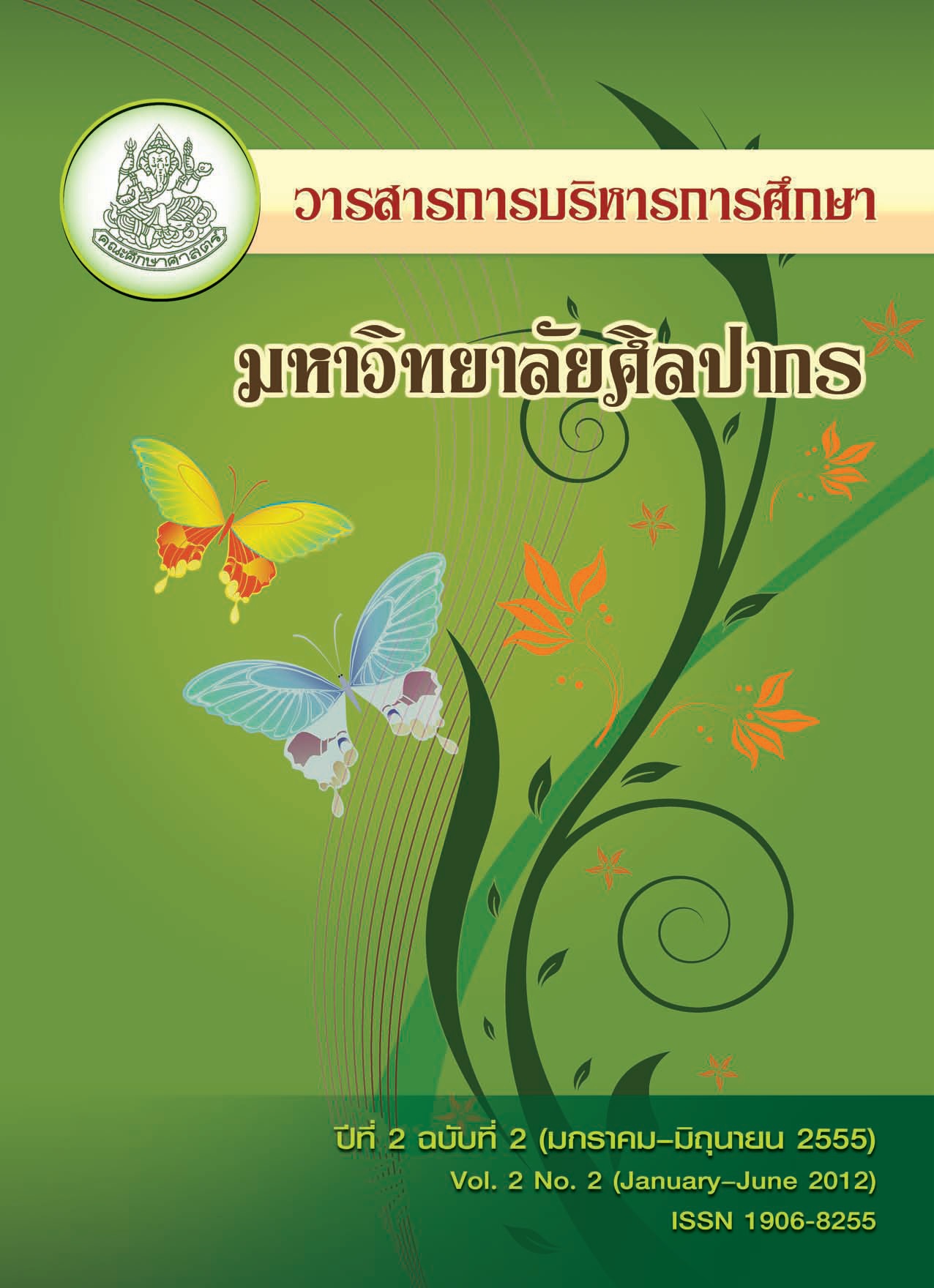การบริหารจัดการศึกษาเพื่อสิทธิเด็กในโรงเรียนมัธยมศึกษา ตามอนุสัญญาว่าด้วยสิทธิเด็ก แห่งสหประชาชาติ
คำสำคัญ:
-บทคัดย่อ
การวิจัยครั้งนี้ มีวัตถุประสงค์เพื่อทราบ 1) องค์ประกอบการบริหารจัดการศึกษาเพื่อสิทธิเด็กในโรงเรียนมัธยมศึกษา 2) รูปแบบการบริหารจัดการศึกษาเพื่อสิทธิเด็กในโรงเรียนมัธยมศึกษา ตามความคิดเห็นของสถานศึกษา 3) รูปแบบการบริหารจัดการศึกษาเพื่อสิทธิเด็กในโรงเรียนมัธยมศึกษา ตามความเห็นร่วมของสถานศึกษาและผู้เชี่ยวชาญ การวิเคราะห์องค์ประกอบและรูปแบบการบริหารจัดการศึกษาเพื่อสิทธิเด็กในโรงเรียนมัธยมศึกษา ตามความคิดเห็นของสถานศึกษา ใช้วิธีวิจัยเชิงปริมาณเครื่องมือที่ใช้ในการเก็บข้อมูล ได้แก่ แบบสอบถาม ผู้ให้ข้อมูลคือ ผู้บริหารโรงเรียน ครู และคณะกรรมการสถานศึกษา จากโรงเรียนกลุ่มตัวอย่าง 44 โรงเรียน รวม 308 คน สถิติที่ใช้ในการวิเคราะห์ข้อมูล ได้แก่ ค่าความถี่ ค่าร้อยละ ค่ามัชฌิมเลขคณิตส่วนเบี่ยงเบนมาตรฐาน การวิเคราะห์องค์ประกอบเชิงสำรวจ และการวิเคราะห์ความสัมพันธ์เชิงสาเหตุ การวิเคราะห์รูปแบบการบริหารจัดการศึกษาเพื่อสิทธิเด็กในโรงเรียนมัธยมศึกษา ตามความเห็นร่วมของสถานศึกษาและผู้เชี่ยวชาญ ใช้เทคนิควิจัยแบบ EDFR (Ethnographic Delphi Futures Research) เครื่องมือที่ใช้ในการเก็บข้อมูลได้แก่ แบบสัมภาษณ์กึ่งโครงสร้าง และแบบสอบถาม ผู้ให้ข้อมูลได้แก่ ผู้เชี่ยวชาญ จำนวน 17 คน สถิติที่ใช้ในการวิเคราะห์ข้อมูลได้แก่ ค่าความถี่ ค่ามัธยฐาน และค่าพิสัยระหว่างควอไทล์
ผลการวิจัยพบว่า
1.องค์ประกอบการบริหารจัดการศึกษาเพื่อสิทธิเด็กในโรงเรียนมัธยมศึกษา ประกอบด้วย 7 องค์ประกอบ ตามลำดับความสำคัญ คือ 1) การพัฒนาผู้เรียน 2) การดูแลช่วยเหลือนักเรียน 3) การจัดสภาพแวดล้อม 4) การเสริมสร้างความปลอดภัย 5) การมีส่วนร่วม 6) การวางแผน และ 7) การส่งเสริมสุขภาพ และยังพบว่าองค์ประกอบด้านการพัฒนาผู้เรียนประกอบด้วยองค์ประกอบย่อยอีก 7 ประการ ได้แก่ 1) การจัดการเรียนรู้ที่มีคุณภาพ 2) การไม่เลือกปฏิบัติ 3) การสื่อสาร 4) ทักษะชีวิต 5) วินัยเชิงบวก 6) การเห็นคุณค่าในตนเอง และ 7) ความรับผิดชอบ
2.รูปแบบการบริหารจัดการศึกษาเพื่อสิทธิเด็กในโรงเรียนมัธยมศึกษา ตามความคิดเห็นของสถานศึกษา พบว่า มี 7 องค์ประกอบ โดยองค์ประกอบด้านการดูแลช่วยเหลือนักเรียน การจัดสภาพแวดล้อม การเสริมสร้าง ความปลอดภัย การมีส่วนร่วม การวางแผน และการส่งเสริมสุขภาพ มีความสัมพันธ์โดยตรงกับองค์ประกอบด้านการพัฒนาผู้เรียน และรูปแบบมีความสอดคล้องกับข้อมูลเชิงประจักษ์
3.รูปแบบการบริหารจัดการศึกษาเพื่อสิทธิเด็กในโรงเรียนมัธยมศึกษา ตามความเห็นร่วมของสถานศึกษาและผู้เชี่ยวชาญ ประกอบด้วย หลักการบริหารจัดการ เงื่อนไขความสำเร็จ การวางแผนและการบริหารจัดการโดยรวม การพัฒนาผู้เรียน การดูแลช่วยเหลือนักเรียน การจัดสภาพแวดล้อม การเสริมสร้างความปลอดภัย การมีส่วนร่วม และการส่งเสริมสุขภาพ
THE EDUCATIONAL ADMINISTRATION FOR CHILD’S RIGHTS IN SECONDARY SCHOOLS UNDER THE UNITED NATIONS CONVENTION ON THE RIGHTS OF THE CHILD
The purposes of this research were to determine : 1) the educational administration factors for child’s rights in secondary schools under the united nations convention on the rights of the child 2) the model of educational administration for child’s rights in secondary schools following schools opinion and 3) the model of educational administration for child’s rights in secondary schools according to schools and experts opinion. The quantitative research strategies are a) studying the variable concerning the education administration for child’s rights and b) conducting factor analysis model. The samples were 44 secondary schools. The respondents were school directors, teachers and school board committees. The instruments for collecting the data were structure questionnaires. The statistics for analyzing the data were frequency, percentage,arithmetic mean, standard deviation, exploratory factor analysis and path analysis. For the model of educational administration for child’s rights in secondary schools, the respondents were 17 experts. The instruments for collecting the data were semi–structural interview and open ended questionnaires. The statistics for analyzing the data were frequencies, median and interquatile range.
The results of this research are as the following:
1. Seven components of the educational administration for child’s rights in secondary schools were 1) student development 2) student protection 3) environment setting 4) safety enchance 5) participation 6) planning and 7) health promotion. Moreover, student development factors comprised of 7 aspects: quality learning management, non-discrimination,communication, life skills, positive discipline, self-awareness, and responsibilities.
2. The components of the model of educational administration for child’s rights in secondary schools according to schools opinion were 7 components which included 1) student protection 2) environment setting, 3) safety enhance 4) participation 5) planning and 6) health promotion which was correlated to 7) student development. In addition, the model demonstrated best fit with the empirical evidence.
3. The model of the educational administration for child’s rights in secondary schools according to schools and experts opinion were principle of administration, conditions for success, guideline and planning for overall administration,student development, student protection, environment setting, safety enhancement, participation, and health promotion.




